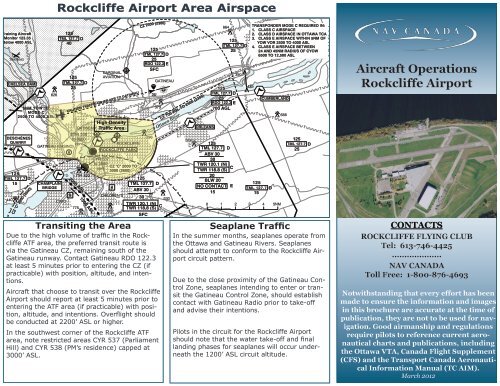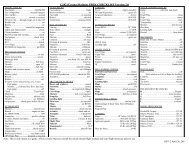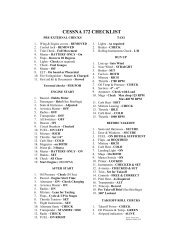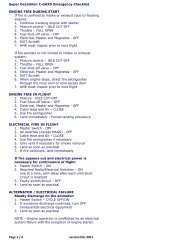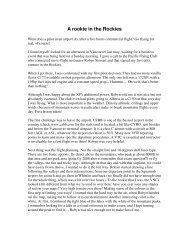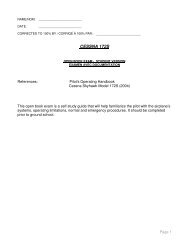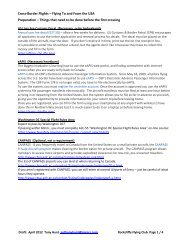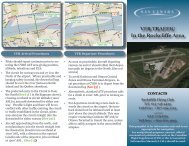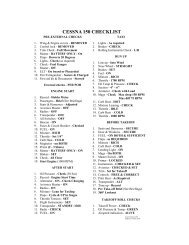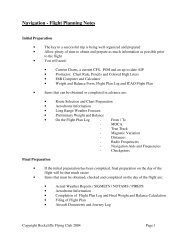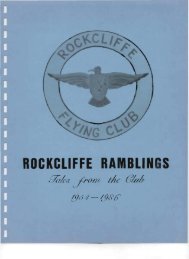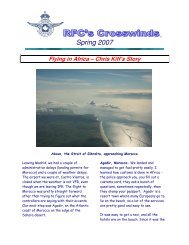Aircraft Operations CYRO - Rockcliffe Flying Club
Aircraft Operations CYRO - Rockcliffe Flying Club
Aircraft Operations CYRO - Rockcliffe Flying Club
Create successful ePaper yourself
Turn your PDF publications into a flip-book with our unique Google optimized e-Paper software.
<strong>Rockcliffe</strong> Airport Area Airspace<br />
CAUTION TRAFFIC ON IFR APR TO GATINEAU<br />
<strong>Aircraft</strong> <strong>Operations</strong><br />
<strong>Rockcliffe</strong> Airport<br />
CYR 538<br />
to 3000<br />
cont<br />
High-Density<br />
Traffic Area<br />
CYR 537<br />
to 3000<br />
cont<br />
Transiting the Area<br />
Due to the high volume of traffic in the <strong>Rockcliffe</strong><br />
ATF area, the preferred transit route is<br />
via the Gatineau CZ, remaining south of the<br />
Gatineau runway. Contact Gatineau RDO 122.3<br />
at least 5 minutes prior to entering the CZ (if<br />
practicable) with position, altitude, and intentions.<br />
<strong>Aircraft</strong> that choose to transit over the <strong>Rockcliffe</strong><br />
Airport should report at least 5 minutes prior to<br />
entering the ATF area (if practicable) with position,<br />
altitude, and intentions. Overflight should<br />
be conducted at 2200’ ASL or higher.<br />
In the southwest corner of the <strong>Rockcliffe</strong> ATF<br />
area, note restricted areas CYR 537 (Parliament<br />
Hill) and CYR 538 (PM’s residence) capped at<br />
3000’ ASL.<br />
Seaplane Traffic<br />
In the summer months, seaplanes operate from<br />
the Ottawa and Gatineau Rivers. Seaplanes<br />
should attempt to conform to the <strong>Rockcliffe</strong> Airport<br />
circuit pattern.<br />
Due to the close proximity of the Gatineau Control<br />
Zone, seaplanes intending to enter or transit<br />
the Gatineau Control Zone, should establish<br />
contact with Gatineau Radio prior to take-off<br />
and advise their intentions.<br />
Pilots in the circuit for the <strong>Rockcliffe</strong> Airport<br />
should note that the water take-off and final<br />
landing phases for seaplanes will occur underneath<br />
the 1200’ ASL circuit altitude.<br />
CONTACTS<br />
ROCKCLIFFE FLYING CLUB<br />
Tel: 613-746-4425<br />
....................<br />
NAV CANADA<br />
Toll Free: 1-800-876-4693<br />
Notwithstanding that every effort has been<br />
made to ensure the information and images<br />
in this brochure are accurate at the time of<br />
publication, they are not to be used for navigation.<br />
Good airmanship and regulations<br />
require pilots to reference current aeronautical<br />
charts and publications, including<br />
the Ottawa VTA, Canada Flight Supplement<br />
(CFS) and the Transport Canada Aeronautical<br />
Information Manual (TC AIM).<br />
March 2012
CIRCUIT RUNWAY 09<br />
DEPARTING AIRCRAFT<br />
ARRIVING AIRCRAFT<br />
CIRCUIT RUNWAY 27<br />
DEPARTING AIRCRAFT<br />
ARRIVING AIRCRAFT<br />
20° Turn<br />
North<br />
20° Turn<br />
North<br />
VFR Arrival Procedures<br />
Pilots should report prior to entering the ATF<br />
area, and if practicable at least 5 minutes prior,<br />
with position, altitude, intentions and ETA.<br />
Pilots transiting through the Ottawa Control<br />
Zone or TCA airspace must remain on the<br />
respective ATC frequency until reaching the<br />
Control Zone/TCA airspace boundary before<br />
switching to the Rockcliff ATF, unless instructed<br />
otherwise by ATC<br />
The circuit for runways 09 and 27 is to the<br />
north of the airport. Where practicable, and<br />
keeping safety in mind, the downwind legs<br />
should be over the river between Kettle Island<br />
and the Quebec shoreline.<br />
The preferred entry to the circuit is from the<br />
south, crossing overhead at circuit altitude<br />
(1200’ ASL) to join mid-downwind for either<br />
runway. If traffic is light and there will be no<br />
conflict with other traffic either entering or already<br />
established in the circuit, pilots may also<br />
join the circuit staight into the downwind for<br />
either runway.<br />
VFR Departure Procedures<br />
As soon as practicable, aircraft departing runway<br />
09 and 27 should offset their departure<br />
path 20 degrees to the north.<br />
Due to the close proximity of the Gatineau Control<br />
Zone, aircraft intending to enter or transit<br />
the Gatineau Control Zone, should establish<br />
contact with Gatineau Radio prior to take-off<br />
and advise their intentions.<br />
*****<br />
Arrival RWY 09<br />
Left-hand circuit<br />
West - Overhead arrival 1700’ ASL with<br />
descent on upwind (south) side then overhead<br />
mid-field at 1200’ ASL to join downwind.<br />
East - Approach from the south, overhead<br />
mid-field at 1200’ ASL to join downwind; or<br />
(traffic permitting), straight -in downwind.<br />
South - Overhead mid-field at 1200’ ASL to<br />
join downwind.<br />
North - Overhead arrival 1700’ ASL with<br />
descent on upwind (south) side, then overhead<br />
mid-field at 1200’ ASL to join downwind.<br />
Arrival RWY 27<br />
Right-hand circuit<br />
West - Overhead arrival 1700’ ASL with<br />
descent on upwind (south) side then overhead<br />
mid-field at 1200’ ASL to join downwind; or<br />
(traffic permitting), straight-in downwind.<br />
East - Overhead mid-field at 1200’ ASL to join<br />
downwind.<br />
South - Overhead mid-field at 1200’ ASL to<br />
join downwind.<br />
North - Overhead arrival 1700’ ASL with<br />
descent on upwind (south) side, then overhead<br />
mid-field at 1200’ ASL to join downwind.


